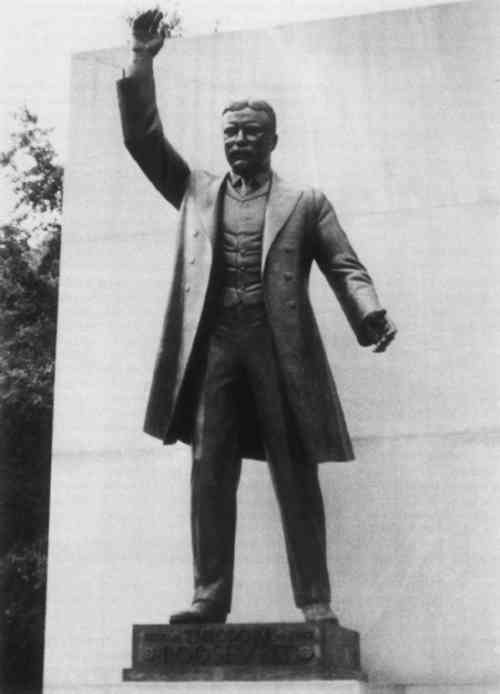CONSERVATION OF A MONUMENTAL OUTDOOR BRONZE SCULPTURE: THEODORE ROOSEVELT BY PAUL MANSHIPLynda A. Zycherman, & Nicolas F. Veloz
1 INTRODUCTIONIN 1932, the United States Congress established a nature preserve on an island in the middle of the Potomac River, at Washington, D.C., to commemorate the contributions of President Theodore Roosevelt to the conservation of wildlife and natural resources. Besides its trails, the 88-acre preserve includes a formal memorial to President Roosevelt at the northern end of the island. Designed by Eric Gugler, this memorial consists of an oval plaza, encircled by a water-filled moat spanned by footbridges. A 17-foot bronze sculpture of the 26th President stands at one end of the plaza, in front of a 30-foot granite shaft (Figure 1).1 Roosevelt is depicted in a characteristic speaking pose, his weight slightly forward, his right hand raised for emphasis. The sculpture was commissioned from the American sculptor, Paul Manship (1885–1966), and cast at the Battaglia Art Foundry, Milan, Italy.2 The ensemble was dedicated in 1967 and is maintained by the National Park Service.
The monumental bronze3 is an example of high quality casting and finishing. The large individual sections were cleanly brazed; only neat rows of fine porosity mark the joins. There are 1/4-inch weep holes on each shoulder, one at the top of the head and several at the bottom of the frock coat. The few casting flaws were filled with circular plugs. A National Park Service Memorandum4 on the subject of the “Finish on Theodore Roosevelt Statue” shows that Manship himself selected Bruno Bearzi, an Italian bronze-caster and conservator, to apply a finish to the sculpture. In May, 1966, prior to the dedication ceremonies scheduled for October, 1967, Bearzi arrived in the U.S. to inspect the statue and apply the finish.5 Though the details of his treatment are not given, Bearzi's instructions for maintaining a satisfactory patina and finish are recorded explicitly. He recommended that the
Judging from the available records in the sculpture's file, it seems that Bearzi's maintenance treatment was not carried out semi-annually, as suggested. From time to time the statue was steam-cleaned and brushed with beeswax in turpentine by National Capitol Parks maintenance personnel. In 1974, dark green pigment was added to the wax, presumably to even out the surface color of the bronze which may have become spotty with corrosion. More recently, National Park Service stan applied dark shoe polish on the legs and shoes to camouflage graffiti which had been scratched through the wax coat exposing bright metal. In 1978, funds from the National Park Service became available to resume the maintenance program of Theodore Roosevelt. |
